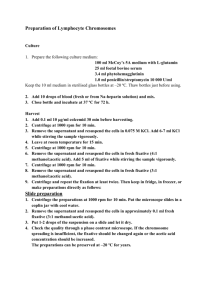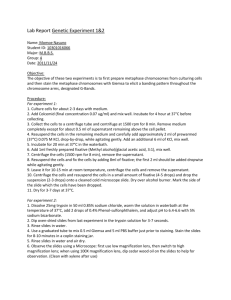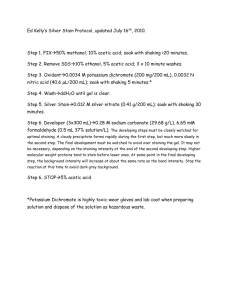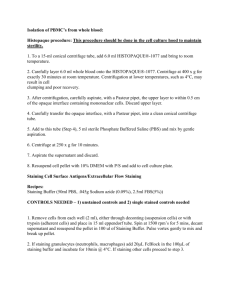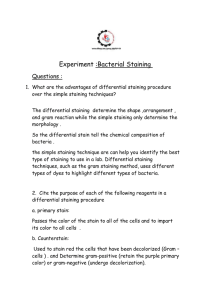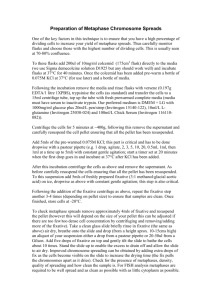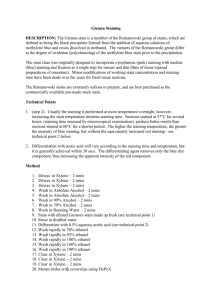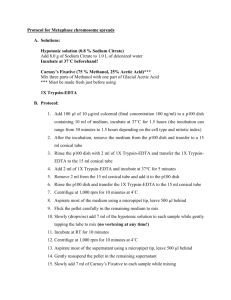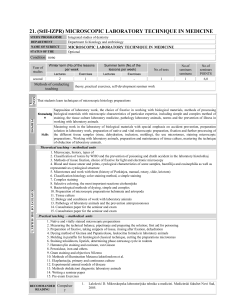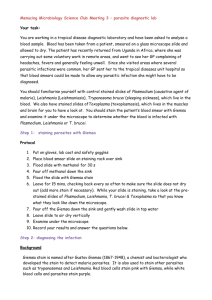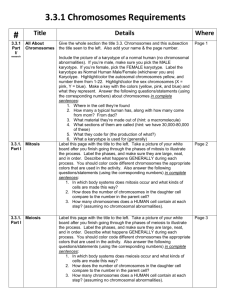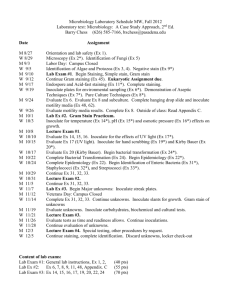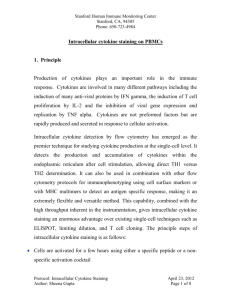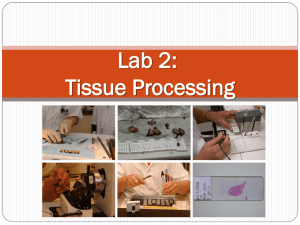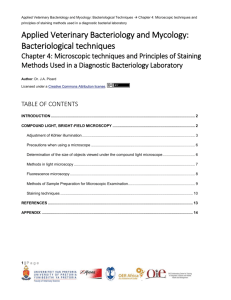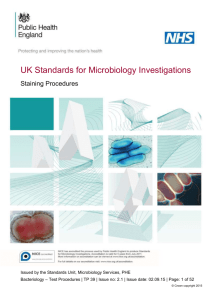Task I/1. Establishment of cell culture and cultivation of peripheral
advertisement
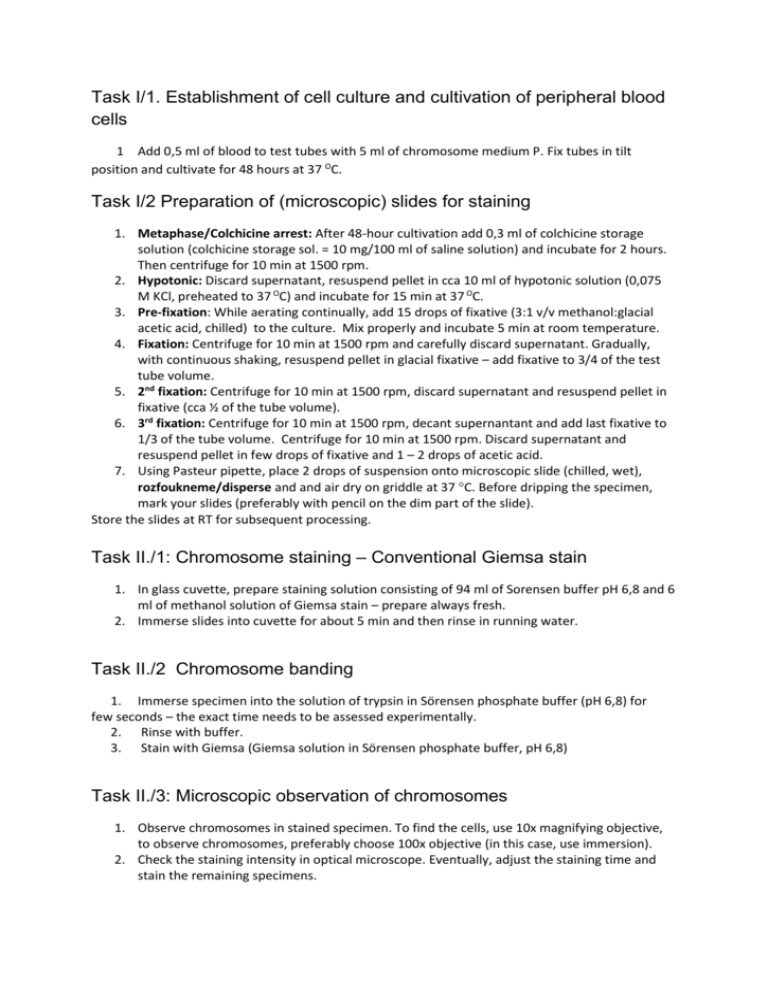
Task I/1. Establishment of cell culture and cultivation of peripheral blood cells 1 Add 0,5 ml of blood to test tubes with 5 ml of chromosome medium P. Fix tubes in tilt position and cultivate for 48 hours at 37 OC. Task I/2 Preparation of (microscopic) slides for staining 1. Metaphase/Colchicine arrest: After 48-hour cultivation add 0,3 ml of colchicine storage solution (colchicine storage sol. = 10 mg/100 ml of saline solution) and incubate for 2 hours. Then centrifuge for 10 min at 1500 rpm. 2. Hypotonic: Discard supernatant, resuspend pellet in cca 10 ml of hypotonic solution (0,075 M KCl, preheated to 37 OC) and incubate for 15 min at 37 OC. 3. Pre-fixation: While aerating continually, add 15 drops of fixative (3:1 v/v methanol:glacial acetic acid, chilled) to the culture. Mix properly and incubate 5 min at room temperature. 4. Fixation: Centrifuge for 10 min at 1500 rpm and carefully discard supernatant. Gradually, with continuous shaking, resuspend pellet in glacial fixative – add fixative to 3/4 of the test tube volume. 5. 2nd fixation: Centrifuge for 10 min at 1500 rpm, discard supernatant and resuspend pellet in fixative (cca ½ of the tube volume). 6. 3rd fixation: Centrifuge for 10 min at 1500 rpm, decant supernantant and add last fixative to 1/3 of the tube volume. Centrifuge for 10 min at 1500 rpm. Discard supernatant and resuspend pellet in few drops of fixative and 1 – 2 drops of acetic acid. 7. Using Pasteur pipette, place 2 drops of suspension onto microscopic slide (chilled, wet), rozfoukneme/disperse and and air dry on griddle at 37 C. Before dripping the specimen, mark your slides (preferably with pencil on the dim part of the slide). Store the slides at RT for subsequent processing. Task II./1: Chromosome staining – Conventional Giemsa stain 1. In glass cuvette, prepare staining solution consisting of 94 ml of Sorensen buffer pH 6,8 and 6 ml of methanol solution of Giemsa stain – prepare always fresh. 2. Immerse slides into cuvette for about 5 min and then rinse in running water. Task II./2 Chromosome banding 1. Immerse specimen into the solution of trypsin in Sörensen phosphate buffer (pH 6,8) for few seconds – the exact time needs to be assessed experimentally. 2. Rinse with buffer. 3. Stain with Giemsa (Giemsa solution in Sörensen phosphate buffer, pH 6,8) Task II./3: Microscopic observation of chromosomes 1. Observe chromosomes in stained specimen. To find the cells, use 10x magnifying objective, to observe chromosomes, preferably choose 100x objective (in this case, use immersion). 2. Check the staining intensity in optical microscope. Eventually, adjust the staining time and stain the remaining specimens. Task III./1: Staining of sex-chromatin 1. Using toothpick, scrape the mucosa on the inside of your cheek. Spread the scrape onto clean microscopic slide in as thin layer as possible. 2. While wet (don’t allow to dry), fix the spread with few drops of ethanol. Let the most of the alcohol dry on air. 3. While still slightly wet, drip 1 – 2 drops of acetoorcein on spread and stain for approximately 1 min. Then cover the stain drop with cover glass. 4. Cover the specimen with cotton wool pad. Through the pad, press your thumb against cover glass to remove the excess stain. Task III./2: Microscopic observation of sex-chromatin and chromosomes – comparison of different staining techniques 1. Observe cells from buccal smear (see task III./1) under the microscope. Use the same observation method as in task II./2. Find Barr bodies in dark red stained nuclei. 2. Under the microscope, observe chromosomes stained using G-banding, C-banding a Rbanding techniques. Compare different staining methods. 3. In permanent specimen stained with G-banding technique, find suitable mitosis and draw it. Try to count chromosomes and determine at least to which morphologic group (A – G) they belong. Task VI.: Identification of chromosomes – karyotype assembly 1. On the plastic slides (supplied by practicals supervisor) are attached pictures of individual chromosomes. Using model, compile the karyotype. 2. Determine, whether the karyotype belongs to man or to woman and write down chromosomal finding according to standard/platný cytogenetic nomenclature. 3. Compile the pathological karyotype and write down chromosomal finding according to standard cytogenetic nomenclature.
